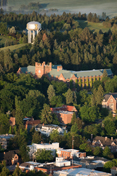The Dirt, March 2022
Message from Department Head
After a COVID-19 break, we are happy to bring you the winter 2022 edition of "The Dirt,” the newsletter of the Department of Soil and Water Systems (SWS). The past two years have been challenging for everyone and our students, faculty and staff are no exception. Faculty have worked hard to offer courses in new ways and maintain a high-quality educational experience for our students.
Research continued despite having limited field crews and travel restrictions. Our UI Extension faculty developed amazing videos and continued to get much needed information to our stakeholders.
To say the least, everyone had to reach deep and take on a little extra to get through this. When considering the progress made since 2020, I am amazed and extremely proud of our unit. The volume and impact of work completed can be explained by our ability to work together and overall dedication to our land grant mission.
I hope that reviewing this newsletter provides you with even a small sense of the positive energy and momentum found in SWS. As always, I invite your questions, feedback and interaction as we continue to forge ahead in 2022.

Sincerely,
Jodi Johnson-Maynard
Professor and Department Head
Our Stories
Exploring Earth’s Subsoil
A facility designed to study soil at depths greater than anywhere else in the world will be built by University of Idaho Soil and Water Systems researchers with support from an $18.9 million National Science Foundation grant.
The Deep Soil Ecotron will enable scientists to conduct experiments on columns of soil up to three meters deep (about 10 feet). Currently, to study soils, scientists often dig pits, which destroys the soil systems as they are uncovered. Also, most research involves just the top 30 centimeters (roughly one foot) of soil. There is a lot to be learned by going deeper, said Michael Strickland, the project’s lead principal investigator.
“Deep soils are probably one of the last research frontiers,” said Strickland, a U of I associate professor of microbial ecology. “Soils are inherently important to life on the planet from supporting plants to driving processes like carbon and nutrient cycling, but a lot of research has been focused on the surface. This facility would enable us to better understand those processes at depth.”
When complete, the Deep Soil Ecotron will contain as many as 24 “eco-units,” essentially huge columns used to study soil cores complete with above-ground plants and below-ground organisms such as insects and microbes. Researchers will be able to control a range of variables including temperature, water and exposure to carbon dioxide and other greenhouse gases. The Ecotron will be housed at the university’s JW Martin Laboratory with renovation expected to start in spring 2022.
Only 13 facilities of this type exist in the world with most located in Europe. None go to the soil depths planned at U of I, and the new Ecotron will give scientists greater ability to monitor and manipulate the eco-units for controlled experiments.
Co-lead investigator Zachary Kayler, who has conducted experiments at the Ecotron in France, said the U of I Deep Soil Ecotron will be a resource not only for the region but for scientists across the country and around the world.
“This facility will represent a huge leap forward in our understanding of soil and terrestrial ecosystems — on the level of space and deep ocean exploration after similar investments,” said Kayler, a U of I assistant professor of biogeochemistry. “We're facing times of uncertainty. We don’t know where the climate trends are going and can’t prepare using past knowledge. This facility will allow us to perform experiments which will help us plan for those future environmental conditions.”
Studies conducted at the Ecotron will improve understanding of how deep soil organisms react to unprecedented conditions, how soil systems respond to agricultural practices and how well they sequester carbon. A range of soils can be studied from the loess found on the Palouse region in Idaho and Washington to soils brought in from the tropics. The eco-units will also be used to develop sensors to monitor deep soils in the field.
This facility puts Idaho on the map as a global leader in deep soil research, said Chris Nomura, U of I Vice President for Research and Economic Development.
“The Deep Soil Ecotron is truly a unique asset in the world that will enable researchers to design new types of experiments and ask questions that were previously impossible to examine,” said Nomura.
While housed at U of I, the Deep Soil Ecotron has multiple collaborators including scientists at University of Colorado, University of Delaware, University of Hawaii, North Dakota State University, Pacific Northwest National Laboratory and University of Wyoming. Most of these institutions are part of EPSCoR, NSF’s program to stimulate competitive research in historically underfunded states. One of the project goals is to create a national network of scientists, starting with these partners, who will conduct experiments at the new facility.
U of I researchers are planning workshops for interested scientists so that experiments can begin as soon as the facility is built. They will also begin recruiting graduate students for a project management training program that aims to teach future scientists how to construct and run research facilities like this one.

Site Helps Track Water Use
OpenET, a new online platform that uses satellites to estimate water consumed by crops and other plants, makes critical data for water management widely available for free in 17 western states for the first time amid record drought.
The open-access platform builds on pioneering work by U of I water resources engineering professor Rick Allen and Idaho Water Resources Department managers to fill a major information gap in water management in the west.
Water is essential to the health of our communities, wildlife and food supply. But access to accurate, timely data on the amount of water used to grow food has been fragmented and often expensive, keeping it out of the hands of many farmers and decision-makers.OpenET allows users to easily view and download this important water data for the current year and previous five years at no charge.
“As someone who has worked on evapotranspiration for more than 40 years, I am thrilled to see multiple independent models for estimating ET come together on a single easy-to-navigate platform,” Allen said. He did his research from the Kimberly Research and Extension Center.
More than 70% of irrigation water ends up as evapotranspiration in some parts of the arid west, U.S. Geological Survey research scientist Gabriel Senay said. Automating calculations for this highly important water data will enable the agency and water managers to more easily create water budgets at the watershed scale to aid proactive water management.
“By putting these water consumption data into the hands of farmers and water managers across the western United States, OpenET will be transformative in helping us manage water more sustainably,” added Ayse Kilic, a professor at the University of Nebraska-Lincoln.
OpenET is providing this data down to the field scale in 17 western states as water supplies become increasingly scarce due to drought, climate change and population growth. The states covered by OpenET are Arizona, California, Colorado, Idaho, Kansas, Montana, Nebraska, Nevada, New Mexico, North Dakota, Oklahoma, Oregon, South Dakota, Texas, Utah, Washington and Wyoming.
The site addresses one of the biggest data gaps in water management in the western United States. “This easy-to-use online platform provides scientifically robust data that are invaluable for water management at all scales, from an individual agricultural field to an entire river basin,” NASA program scientist Forrest Melton said. He is based at the Western Water Applications Office.
“As water supplies become increasingly scarce in arid regions, we need new innovative tools like OpenET to manage water more precisely and sustainably,” said Robyn Grimm, director of climate resilient water systems at the Environmental Defense Fund. Farmers, policymakers and communities big and small can access the same high-quality data on water use to develop more resilient water supplies across the west.
“OpenET is a powerful application of cloud computing that will make a measurable impact on the ground in the agriculture sector. Google is proud to support such an important new tool to help improve water sustainability in the western United States as we see the impacts of climate change intensify,” Google Earth Engine developer advocate Tyler Erickson said.
Advocates hope to expand the platform to other arid regions including South America, India and Africa, Desert Research Institute research professor Justin Huntington said.
“Irrigated agriculture is essential to feeding a growing population,” USDA research scientist Martha Anderson said. “OpenET will be a powerful tool to help our nation’s farmers increase food production under conditions of limited freshwater resources.”

Students Revive Soil Judging Team
After a nearly two-year COVID-19 hiatus, the department’s Soil Judging Team is digging back — into their own soil pits, that is. The team, made up of six dedicated undergraduate students, was invited to the Soil Society of America’s national judging contest, held in April 2022 at Ohio State University.
Soil judging is an organized collegiate competition involving the technical description and interpretation of soil profiles. Students on the team develop hand-texturing skills, practice identifying soil horizons and classify the profiles according to USDA’s soil taxonomic system. At the competition site, students will characterize multiple soil pits and be evaluated on their ability to identify soil morphological features.
The students have been meeting weekly in the classroom to learn how to describe soils. With the help of graduate student and judging alumni Paul Tietz, the team has been coached on soil formation processes and the taxonomy of soils within Ohio. Once the snow melts here in Moscow, the team anticipates taking a few local field trips to practice their skills in real pits.
The team is incredibly enthusiastic at the prospect of representing the University of Idaho and the department at this nationwide event. To participate in the national contest, students and coaches set a fundraising goal of $6,000 for the purchase of new teaching materials and to cover the majority of travel costs.
If you would like to help the team, please consider donating online. Donations can also be made by mailing a check (made payable to University of Idaho Foundation, with Soil Judging Team in the memo line) to 875 Perimeter Dr, MS 2331, Moscow, ID 83844-2331. — Written by Paul Tietz and Amanda Bauer

Faculty and Student Success

Associate Professor Erin Brooks received a U of I Presidential Mid-Career Award for his record of accomplishment and demonstrated dedication to teaching, outreach and research.

Professor Bob Mahler received an Outstanding Associate Editor Award for his service to the Journal of Natural Sciences Education.

Assistant Professor Laurel Lynch received a $1.1 million grant from the National Science Foundation to lead a team of international researchers to study the impact of scavengers on carbon and nutrient cycling.
Associate Professor Erin Brooks, Professor Jodi Johnson-Maynard and Instructor Marvin Heimgartner received a gift from CHS Primeland to create a new precision agriculture certificate. The 12-credit program is open to any U of I student.

Maggi Laan, a master’s student studying soil and land resources, is working with Daniel Strawn and Zachary Kayler on a research project focused on promoting the dairy bioeconomy by using dairy waste streams as alternative fertilizers. The team is using spectroscopic, isotopic and chemical extraction techniques to understand phosphorus speciation and availability in soils amended with nutrients recovered from dairies. This work supports the growing dairy industry in Idaho by providing information on the ability to recycle nutrient dense wastes.

SWS graduate students Torrey Stephenson and Amanda Bauer dominated the U of I Three-Minute Thesis Competition with Torrey claiming first place and Amanda finishing in third place. Torrey is studying intercropping under Zachary Kayler and Amanda is studying how microbial communities respond to irrigation with Michael Strickland.
Personnel changes
Courtney Cosdon joined SWS as UI Extension instructor for soil health in Dec. 2021. She is located in Boise at the Idaho Water Center but will serve the larger southern Idaho region. Courtney’s position is jointly funded through UI Extension and USDA-NRCS and serves as an up-to-date source on soil health education and information.
Upcoming retirements include Howard Neibling (March 31) and Richard Allen (June 30). Both Howard and Richard have had long and impactful careers that have served the scientific and stakeholder communities. The loss will be felt across our department and the state, but SWS is dedicated to continuing the important research and Extension programs they each established.
SWS has launched a search for a new faculty member in the area of precision agriculture to fill vacancies left by Sanaz Shaffian and Jason Kelly. We hope to have the new person onboard for the fall 2022 semester.


In Memoriam
Maynard Axel Fosberg, professor emeritus of soil science and soil morphology, passed away on Sept. 18, 2020, at the age of 101. Maynard shared his passion for soil science with students, staff and faculty for over 40 years. Among the many contributions made over his career and into retirement are the Maynard Fosberg Monolith Collection and the Maynard Fosberg Land Judging and Soil Science Endowment. The monoliths, which adorn the halls of the Agricultural Sciences building, serve as an invaluable teaching resource. The endowment has helped support land judging throughout the state and undergraduates studying soil science since 1985. Maynard was a great friend and supporter of the department and the discipline of soil science.
Edwin Arthur Dowding, professor emeritus of agricultural engineering, passed away on Sept. 25, 2020, at the age of 84. Ed taught courses in structures and machinery, which were required for the agricultural systems management (ASM) program that remains the largest undergraduate program within the department. Ed served the University of Idaho for 24 years and retired in 1999. He was a member of the American Society of Biological and Agricultural Engineering and was affiliated with the Moscow Central Lions Club. One of Ed’s passions was his ASM students. At his family’s suggestion, donations in his name can be made to Agricultural Systems Management through the University of Idaho Foundation.
Janice “Jan” Elizabeth Pitkin passed away Jan. 21, 2020, at her home in Moscow. Jan worked at the University of Idaho in the News Bureau before transferring to the Department of Plant, Soil and Entomological Sciences where she worked for almost 16 years. Jan was assigned to the soil science division for a number of years during which she assisted countless students, faculty and staff. Jan transferred to the College of Natural Resources in the Department of Forest Products where she worked for another 10 years prior to her retirement.
Feedback or suggestions? Please pass them along through calsnews@uidaho.edu.
Sign up to receive The Dirt.
















